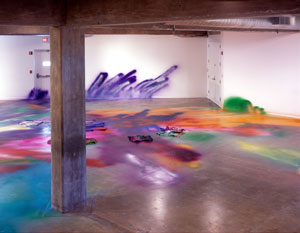The gratification of spray paint, from a vandal’s point of view, is immediate.
Spray paint possesses a readymade violence that distinguishes it from any other medium. Graffiti artists take full advantage of its quick-drying properties and bold color to claim territory as their own — a controversial practice that can appear either beautiful or destructive, depending on the viewer’s perspective. It is rare that an aesthetic style can simultaneously occupy the opposite extremes of beauty and destruction; no wonder critic Arthur Jafa called graffiti the only legitimate successor to Abstract Expressionism.
Both styles play a part in the work of Katharina Grosse, a German artist known for her site-specific works rendered in spray-paint and whose latest installation is currently on view in the lower level of the Contemporary Arts Museum. In the past, Grosse has covered walls and billboards; at CAM she has concentrated her efforts underfoot. It is a chaotic mess in which flashy colors sweep across the floor and occasionally splash onto the walls, while objects such as newspapers, books, an old blanket, and hollow eggs are strewn over the concrete and almost disappear underneath layers of paint.
There are a few stunning moments. In Grosse’s skilled hands, the air gun yields surprisingly Impressionistic, pulsating patterns. She uses color with courageous abandon, and has an intuitive understanding of spatial dynamics, evidenced by a wave of green and red that crests on the glass door of the education room adjacent to the gallery. In some areas, the reticulation of the paint resembles cobwebs or masses of soapy bubbles, a delicate effect that breaks up the monotony of broad patches of electric hues. One corner is a gorgeous combination of iridescent ivory and vibrant azure that contains strange, amorphous shapes like jellyfish shimmering underwater.
Unfortunately, the CAM installation does not cohere as a whole. The presence of objects is baffling. They contribute nothing to the overall composition; in fact, they interfere with the rhythm of the paint in a way that is distracting.
It is interesting to compare the CAM piece to Lynda Benglis” ‘spills” of the late 60s, which consisted of pigmented latex poured onto concrete floors. A key difference is that Grosse lets you walk on the art. But Benglis” latex swirls seem decadent and lush, while at CAM, Grosse’s work suffers from a sense of restraint. It might be different if the paint had been allowed to spread, like a virus, into the museum bookstore, or over the exit signs. Instead it never manages to fully overcome the confines of the space. One of the reasons graffiti never took off as an art-world commodity during the 80s is that it loses its power when permanently affixed to a canvas. Grosse wisely chooses not to fight the fugitive nature of spray paint. This should allow one to take big risks; but in this situation, the work feels subdued. A vandal, as Webster’s New World dictionary defines the word, is one who destroys “that which is beautiful or artistic.” If Grosse had indulged her inner vandal, maybe the piece at CAM would be more exciting. Instead, the finished product is neither beautiful enough nor sufficiently destructive to have any lasting impact.
Image courtesy the artist and Contemporary Arts Museum, Houston, Photograph by Paul Hester
Claire Barliant is a critical studies fellow at the Core Program.




